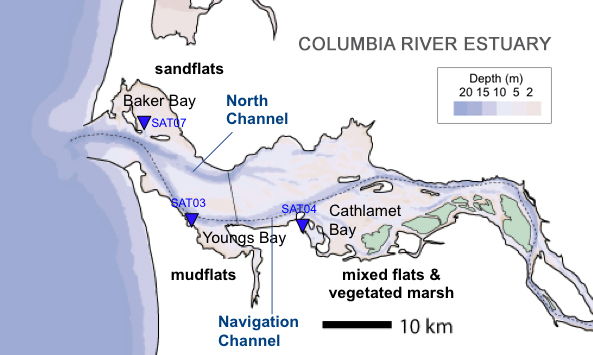You are here
CMOP Research to Provide Insight into Biogeochemical Exchange Between Bays and Estuary
02/08/13 Portland, Ore.
Scientists from the Center for Coastal Margin Observation and Prediction (CMOP) are studying the biogeochemical exchange between three bays and the Columbia River estuary to gain scientific insight of how metabolic processes affect the overall health of the estuarine ecosystem.
 Tidal marshes and flats in lateral bays contribute to Columbia River estuary biogeochemistry.The research - led by Fred Prahl Ph.D., Oregon State University, Jim Lerczak Ph.D., Oregon State University, and Joseph Needoba Ph.D., Oregon Health & Science University - is part of a CMOP science initiative to develop approaches and models to quantify the contribution of lateral bays to the estuary as a bioreactor.
Tidal marshes and flats in lateral bays contribute to Columbia River estuary biogeochemistry.The research - led by Fred Prahl Ph.D., Oregon State University, Jim Lerczak Ph.D., Oregon State University, and Joseph Needoba Ph.D., Oregon Health & Science University - is part of a CMOP science initiative to develop approaches and models to quantify the contribution of lateral bays to the estuary as a bioreactor.
CMOP uses the term "estuarine bioreactor” as the summation of the effects of ecological hotspots, ocean-estuary exchanges and river forcing on nutrient cycles and energy flow at an ecosystem scale.
“Our hypothesis is that the lateral bays are biological and biogeochemical hotspots due to their increased residence time to the estuary and the significant interaction with the land margin through tidal pumping,” Prahl said.
“Since three distinct lateral bays (Cathlamet, Youngs and Baker Bays) are located along a gradient of salinity and therefore estuarine mixing, their collective study provides an excellent opportunity for comparative biogeochemical study.”
 Location of SATURN-04 observatory (red dot) and Forerunner sampling transect in Cathlamet Bay.The CMOP team’s initial fieldwork focused on two areas of Cathlamet Bay – the major freshwater intertidal region at the head of the Columbia River Estuary. These areas are a lateral transect across the face of this intertidal region and SATURN-04, a scientifically advanced observation station operating continuously at the seaward end of Cathlamet Bay. The research team split up into three groups to conduct the study – two aboard a ship and one on land.
Location of SATURN-04 observatory (red dot) and Forerunner sampling transect in Cathlamet Bay.The CMOP team’s initial fieldwork focused on two areas of Cathlamet Bay – the major freshwater intertidal region at the head of the Columbia River Estuary. These areas are a lateral transect across the face of this intertidal region and SATURN-04, a scientifically advanced observation station operating continuously at the seaward end of Cathlamet Bay. The research team split up into three groups to conduct the study – two aboard a ship and one on land.
Aboard the Training Vessel Forerunner, Lerczak's group took regular measurements along the transect using a profiling instrument package that collected data on conductivity, temperature, DO, Chl-Fl and NTU as a function of water column depth. At the same time, Needoba's group collected water samples at two depths (surface and near bottom) and processed them in a small lab setup in the ship for later analysis at OHSU. These samples will be analyzed for concentrations of dissolved (nutrients, methane, total ‘dissolved’ Mn and Fe, and CDOM) and particulate (organic carbon / nitrogen and chlorophyll) constituents.
Meanwhile at SATURN-04, Prahl's group collected water samples at the surface and near bottom every hour. They transported them to the Marine and Environmental Research and Training Station (MERTS, Clatsop Community College) - a short drive from the observation station - where a lab was setup to process them for latter analysis elsewhere and for immediate analysis of dissolved methane.
Prahl used a new gas equilibrator – laser-based, cavity ringdown infrared spectrometer – under development - for high temporal resolution measurement of dissolved methane during the high and low river flow periods in June and September, respectively. Also collaborating on the study was John Crusius, a scientist from the US Geological Survey, who made high resolution measurements of dissolved radon, a proxy for groundwater discharge, using a gas equilibrator – alpha decay spectrometer system.
The data collected from the lateral bay research will be used in a new modeling tool being developed by CMOP modelers called the “box model.” Clara Llebot Ph.D., an OHSU post-doctoral researcher in the lab of António Baptista Ph.D. and Yvette Spitz, Ph.D., develops biogeochemical models that represent the whole estuary. Llebot says a box modeling approach will help with the development and refinement of her more sophisticated whole estuary models.
“Our box model is a MATLAB set of programs that aim to gain insight on the biogeochemical behavior of the Columbia River estuary by means of evaluating the interactions between a few boxes that simplify the whole estuary,” Llebot said.
When completed, the box model will be able to take a whole year of data and produce generate biogeochemical results in a few minutes. Llebot says the results are less precise than what we would find if we ran the same simulations in a fully coupled ecosystem/circulation model, but they are also much faster to generate and more user-friendly.
“By using observational information to develop numerical models, we will be able to gain better scientific understanding into the contributions that biogeochemical exchanges have on the estuarine bioreactor under different natural and human-influenced physical forcing conditions,” Prahl said.
This research is funded by the U.S. National Science Foundation.
Written by Jeff Schilling
###
The Center for Coastal Margin Observation & Prediction (CMOP) advances scientific understanding of the coastal margin environments that sustain much of the world's population. As a multi-institutional National Science Foundation Science and Technology Center, CMOP characterizes complex physical and biogeochemical processes at work in river-to-ocean ecosystems and explores links between environmental and human health. The center is a collaborative effort of many academic and industry partners, lead by Oregon Health & Science University (host institution), Oregon State University, and University of Washington.






